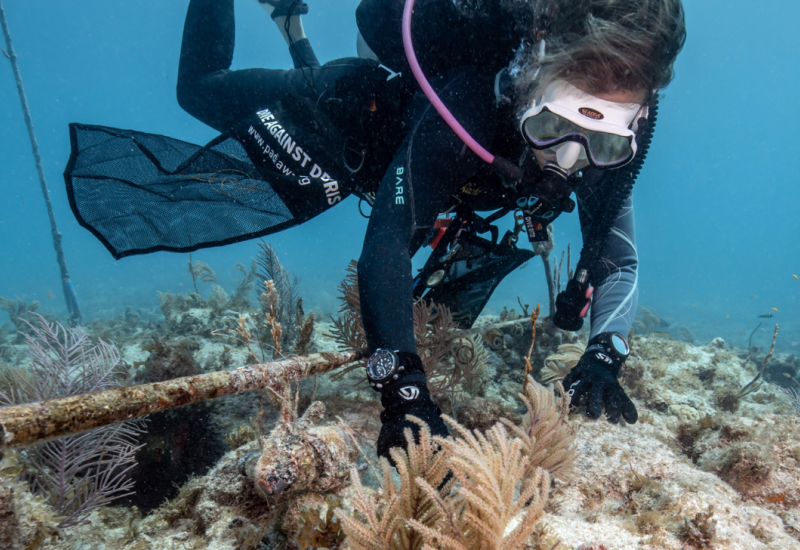A Diver’s Guide to the Lower Keys
Once you’ve ticked off the many impressive sites in Key Largo, Islamorada and Marathon, you’ll arrive in yet another natural Florida Keys wonderland — the Lower Keys. A stunning swath of the archipelago that curves gently westward on its way to the end of the road in Key West, the Lower Keys is a destination all its own. And there’s tons of fun to discover here, both below the water’s surface and above.
Big Pine Key is the second-largest island in the Florida Keys and the main island in these parts, and this is where you can spot the elusive Key deer, a diminutive cousin of the mainland variety. The Lower Keys starts on the western end of Seven Mile Bridge and stretches all the way to Stock Island, just before Key West. And among the islands to explore are Big Coppitt Key, Sugarloaf Key, Cudjoe Key and others. Nature, of course, is at every turn in these parts — at the Lower Keys’ two national wildlife refuges, within the national marine sanctuary and at the waterfront Bahia Honda State Park(home to some of the best tent-camping sites anywhere) too. For divers, the biggest thrills await within Looe Key National Marine Sanctuary, home to some amazingly well-preserved coral structures and a marine life population that makes “thriving” seem like an understatement.
REEF TREASURES
Have you ever gotten lost in the striking yellow and blue hues of a queen angelfish from mere feet away, or found yourself marveling at a grove of staghorn coral only to be distracted by an eagle ray winging by in the blue? Encounters like these are just a sampling when it comes to potential run-ins you may have out for a dive at Looe Key National Marine Sanctuary (say: loo). The reef lies about 5 nautical miles off Big Pine Key and is punctuated by more than 50 mooring balls to mark the many dive sites within the spur-and-groove reef system. Captain Hook’s Looe Key Reef Adventures and Strike Zone Charters regularly brings divers to three sanctuary preservation areas that are part of the Florida Keys National Marine Sanctuary, among them Looe Key Reef. Dive trips usually allow times for two dives on different sections of the reef, where the depths range from as shallow as 5 feet to a maximum depth of about 70 feet. Prepare to see fish life as soon as you enter the water because goliath grouper love to approach the shadows of moored boats. On the reef itself, look for eels, huge parrotfish, more goliath grouper and perhaps some of the resident reef sharks too.

Florida KeysMarvel at a grove of staghorn coral when diving in Looe Key National Marine Sanctuary. Keep an eye out for eels, huge parrotfish, goliath grouper and perhaps some of the resident reef sharks.
You could spend your entire vacation diving Looe Key, but wreck fanatics never miss a dive on the Adolphus Busch Sr. The 210-foot-long, completely intact freighter was intentionally sunk off Big Pine Key in 1998 and bottoms out at 110 feet in the sand. But midship is where the bulk of your dive will likely take place, and where you might be lucky enough to spot lemon sharks and, during the summer months, enormous schools of silversides. Opportunities for light penetration await advanced divers within the ship’s cargo holds, where goliath grouper are prone to lurk. Looe Key Reef Resort and Dive Center makes several trips a week to dive the wreck, and follows the adventure with a second, shallower dive on Looe Key Reef or a guided drift dive along a wall.
SPOT A KEY DEER
You can’t say you’ve been to the Florida Keys until you’ve spotted one of the islands’ most adorable denizens. We’re talking about the endangered Key deer, a smaller-bodied subspecies of white-tailed deer that lives only in the Lower Florida Keys. While the animals can often be spotted traipsing between houses and across lawns within neighborhoods on Big Pine Key and No Name Key, you’re best off going to see them at the National Key Deer Refuge on Big Pine Key, a facility devoted to their protection and preservation. Early morning and right around sunset are the best times to spot the deer feeding on grasses here in the pine rock land and hardwood hammock habitats.
DINING HIGHS IN THE LOWER KEYS
A day in the Florida Keys is hardly done and dusted before you’ve raised a glass to the sunset and sunken your teeth into something deliciously local. If you happen to have hooked your own fish for dinner, head to Kiki’s Sandbar & Grille on Little Torch Key to have it grilled and served up with beautiful views of Newfound and Marsh harbors. The menu’s got you covered even if you’re not a lucky angler too, with tasty offerings such as Bahamian conch fritters, coconut shrimp, mahi mahi tacos and fresh-caught yellowtail snapper.
Right off the Overseas Highway on Big Pine Key, Milagro Restaurant and Bar is a polished little spot perfect for a romantic dinner, with things like grilled octopus and cherrywood-grilled swordfish on the menu.
Also on Big Pine Key, sink your teeth into the divine chilled lobster salad, grouper soft tacos and peel-and-eat shrimp at the Bucktooth Rooster, a favorite for family dining.
And 18 holes of mini golf at the only mini golf course in the Florida Keys await families looking for an active dinner at Boondocks, where you can play a round pre- or post-feasting on the kitchen’s Southern-inspired Keys cuisine (don’t miss the local hogfish when it’s on the menu).
When you’ve got an appetite to dive — and for all the other good things in life too — the Lower Keys has you covered.
For more information visit fla-keys.com/lower-keys
Plan Your Trip
Hover over the points on our interactive map below to see more of what The Florida Keys has to offer.











